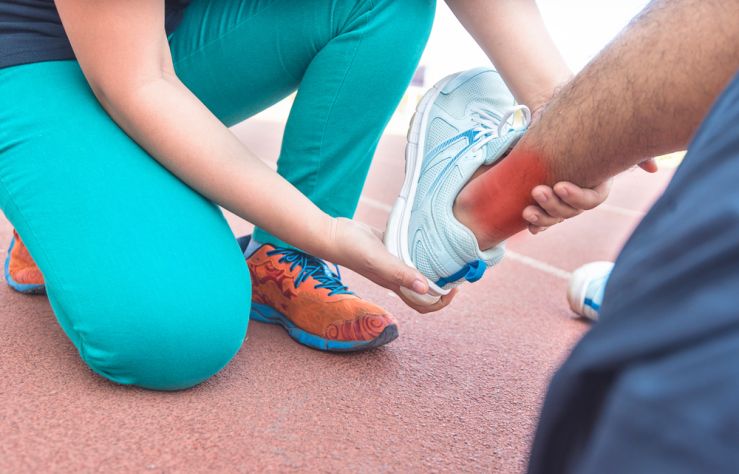
Sprains and Strains: What’s the Difference?
Everyone has suffered a sprain or strain at some point in their life. Whether it’s a rolled ankle during a sporting event or a sore wrist after a fall, these nuisance injuries happen remarkably often. In fact, it’s estimated that 25,000 Americans suffer from an ankle sprain every single day.
However, most people don’t know the difference between the terms “sprain” and strain.” They are often used interchangeably despite the fact that they affect different parts of the body. So, what is the difference between a sprain and a strain?
Strains vs. Sprains Symptoms
The main difference between a strain and sprain is whether it affects a ligament, muscle, or tendon. A strain occurs when a ligament, the tissue which connects bones to other bones, is overstretched or torn. Meanwhile, a sprain occurs when the muscle itself or the tendon which holds it to the bone is torn or overstretched.
For the most part, sprains and strains have the same symptoms. This is part of the reason they are so commonly confused. Both injuries result in pain around the affected area, swelling, and a decrease in the joint’s range of motion.
However, it is possible to tell a sprain from a strain. The latter is typically accompanied by muscle spasms while a sprain usually results in bruising.
Causes & Risk Factors
Sprains and strains are typically the result of a sharp, unexpected movement such as twisting an ankle or moving in an awkward position. Naturally, athletes are more susceptible to both injuries since they run, jump, fall, and make physical contact more during sports activities. However, anyone can suffer from a sprain or strain. In fact, one can even develop over time as the result of repetitive movements.
Treatment for Sprains & Strains
While severe sprains and strains may require more aggressive treatment, most mild to moderate ones can be treated at home with the RICE technique. The acronym stands for:
-
Rest: Staying off the injury gives it time to heal on its own.
-
Ice: Cold temperatures help reduce swelling in the area. A good rule of thumb is to apply ice wrapped in a cloth for 20 minutes, remove it for 20 minutes, and repeat. This can be done as much as tolerated for the first day or two after the injury.
-
Compression: Wrapping the area of a sprain or strain with an elastic bandage or neoprene brace can also help reduce swelling and provides support for the joint.
-
Elevation: Finally, elevating the injury above the level of the heart can help reduce swelling. Fortunately, this can be done at the same time as icing, resting, and using compression.
Most mild sprains and strains will heal fully within a few days to a few weeks depending on the severity. If it doesn’t start to feel better after two or three days of using the RICE method, you should consider seeking medical care.
Prevention of Sprains and Strains
While the RICE method is effective at treating most sprains and strains, preventing them is even better. Certain things, like stretching before exercise, can help athletes and non-athletes alike avoid the injuries. Meanwhile, exercising regularly helps strengthen joints and keeps muscles flexible. For those who engage in repetitive motions on a daily basis, taking breaks is important to helping avoid sprains and strains that develop over time.
Velocity Urgent Care Is Here to Help
If you find yourself suffering from a sprain or strain and feel that the RICE method isn’t helping, never fear. Our team at Velocity Urgent Care is ready to provide high-quality care on your schedule. Using state-of-the-art digital x-ray we can assess whether your pain is due to a simple sprain or strain or whether there’s a bone or joint condition that requires further treatment. Whether you want to book an appointment ahead of time online or just walk-in, our team of friendly, board-certified physicians, physician assistants and nurse practitioners will get you back to feeling 100% in no time.
Velocity Urgent Care is a partnership with Sentara Healthcare, providing referral and chart access to over 3,800 generalists and specialists including orthopedics, orthopedic surgery, hand surgery, and physical therapy. If your injury turns out to be more severe than a simple strain or sprain, we’ll make sure you have access to the best care possible with a rapid referral.
We are the exclusive in-network provider for several local insurance plans meaning you can be seen for the cost of your co-pay and deductible. All Velocity Urgent Care locations also accept Medicare, Medicaid, and Tricare. Our 15 clinics across Hampton Roads, in Woodbridge, and in South Boston, Virginia are here and ready to help should you suffer a sprain or strain. We’ll get you in and out quickly so you can start getting better.
Loading Conversation
